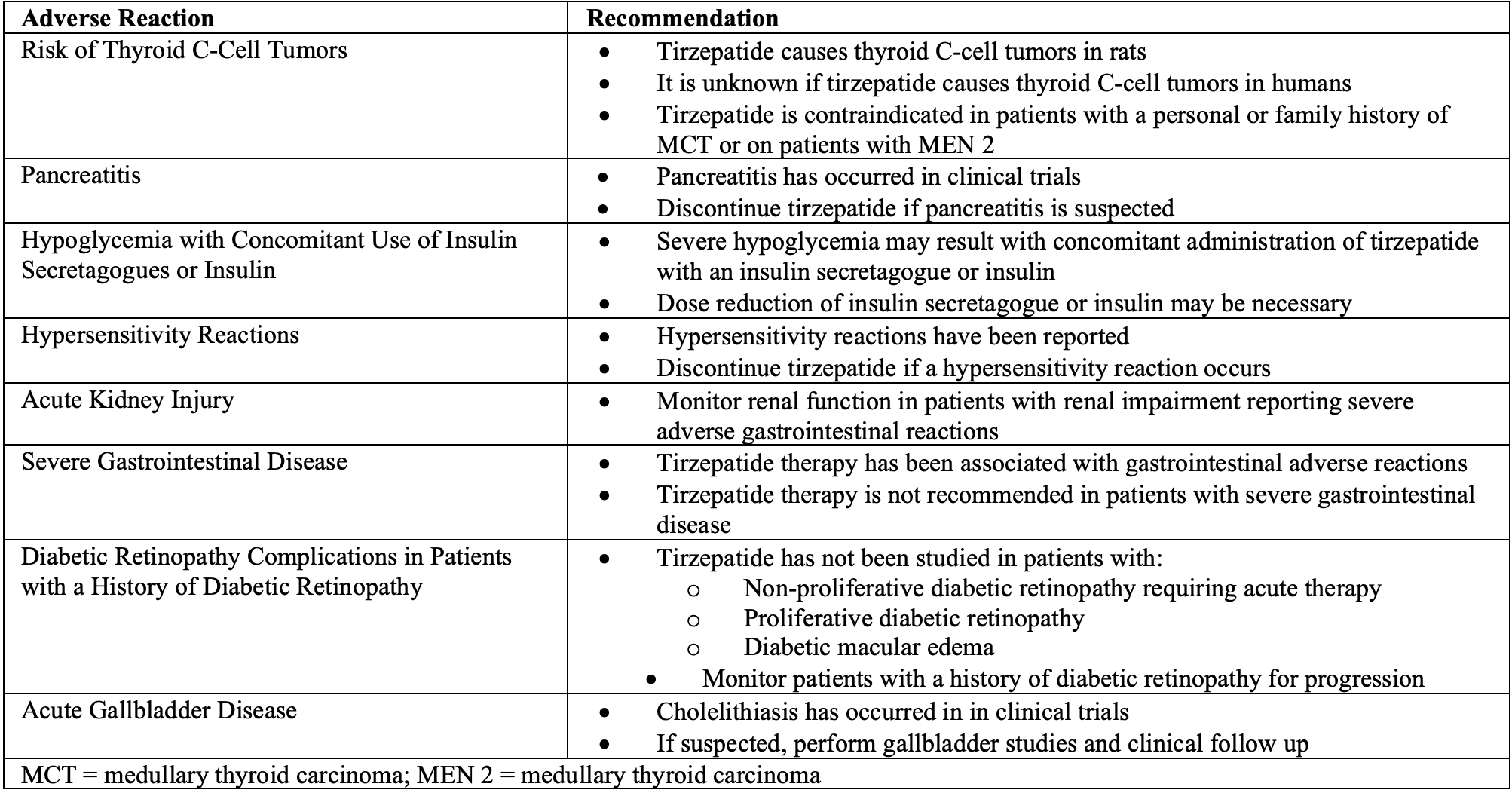Article
Clinical Overview: Tirzepatide (Mounjaro) for Type 2 Diabetes Mellitus
Author(s):
Tirzepatide is a dual receptor agonist, acting on glucose-dependent insulinotropic polypeptide and glucagon-like peptide-1 to lower blood glucose levels.
Introduction
Tirzepatide (Mounjaro) is an FDA-approved, novel medication indicated as an adjunct to diet and exercise in the treatment of patients with type 2 diabetes mellitus. Tirzepatide is a dual receptor agonist, acting on glucose-dependent insulinotropic polypeptide (GIP) and glucagon-like peptide-1 (GLP-1) to lower blood glucose levels. Tirzepatide previously received a priority review and received approval by the FDA on May 13, 2022.1,2
Clinical Trials
The approval of tirzepatide was based on information from 5 clinical trials in the SURPASS clinical trial program.1,3 The program assessed tirzepatide's safety and efficacy as an adjunct to diet and exercise in improving glycemic control in patients with type 2 diabetes mellitus.
The trials evaluated tirzepatide as monotherapy, in combination with oral anti-glycemic medications including metformin, sulfonylureas, and/or sodium-glucose co-transporter 2 (SGLT2) inhibitors, and in combination with insulin. In comparison with placebo, adults with type 2 diabetes mellitus in all trials experienced a statistically significant reduction in baseline hemoglobin A1c (HbA1c).
The SURPASS-1 trial was a 40-week double-blind trial that evaluated tirzepatide as monotherapy in addition to diet and exercise. At the end of 40 weeks, patients treated with tirzepatide had an average HbA1c reduction of 1.7% as compared to placebo with more than 78% of patients achieving an HbA1C of less than 7%. Average weight loss was also significant at the end of the 40 weeks at an average of 6.3-7.8 kg per patient.1
Preliminary results from the SURMOUNT-1 clinical trial evaluating tirzepatide in the treatment of overweight or obese adults are promising, with an average weight loss of 16% or more compared to placebo.3
Dosage and Administration1
Tirzepatide is available as a pre-filled, single-dose, 0.5 mL pens in 2.5 mg, 5 mg, 7.5 mg, 10 mg, 12.5 mg, and 15 mg. The solution is clear and colorless to slightly yellow, preservative-free, and stored in the refrigerator at 2°C-8°C (36°F-46°F) in the original carton to protect from light.
The starting dose of tirzepatide is 2.5 mg, administered by subcutaneous injection once weekly for 4 weeks. The 2.5 mg dose is for treatment initiation, not for glycemic control. After 4 weeks, the dose is increased to 5 mg subcutaneous once weekly. If additional titration is necessary for glycemic control, the dose is increased in increments of 2.5 mg every 4 weeks up to the maximum dose of 15 mg once weekly.
Administration may occur at any time of day, with or without food. Injections sites include the abdomen, thigh, or upper arm and patients should rotate the site with each dose.
Instruct the patient to inspect the pen before administration to ensure that the solution is clear and colorless to slightly yellow; if particulate matter or discoloration is present, advise the patient to discard the pen.
When tirzepatide is used in combination with insulin, the injections are administered as separate injections; they cannot be mixed. Patients may administer injections in the same body region providing the injections are not adjacent.
If patients miss a dose of tirzepatide, they should administer it as soon as possible. If they cannot administer the dose within 4 days (96 hours), they should skip it and inject the next dose at the usual time. Changing the day of weekly administration is possible if the time between the 2 doses is at least 3 days (72 hours).
Contraindications
Tirzepatide is contraindicated in patients with a personal or family history of medullary thyroid carcinoma or patients with multiple endocrine neoplasia syndrome type 2. See Table 1 for additional information.1
Warnings and Precautions
Table 1 summarizes the warnings and precautions associated with tirzepatide.1

Adverse Reactions
The most common adverse reactions observed in clinical trials of tirzepatide include:1
- Nausea
- Diarrhea
- Decreased appetite
- Vomiting
- Constipation
- Dyspepsia
- Abdominal pain
Drug Interactions
Tirzepatide delays gastric emptying and has the potential to alter absorption of oral medications. This is important in patients taking narrow therapeutic index drugs or drugs that need a minimum blood level for efficacy. Advise patients taking oral contraceptives to switch to a non-oral contraceptive method or add a barrier contraceptive method for 4 weeks after initiation of tirzepatide and for 4 weeks after each dose escalation.1
Pregnancy and Lactation
Based on animal studies, tirzepatide may cause fetal harm, but data are insufficient to evaluate the safety of tirzepatide in pregnant women. There are no data on the presence of tirzepatide in human milk, the effects on the breastfed infant, or the effects on milk production. Only use tirzepatide during pregnancy or lactation if the potential benefits outweigh the potential risks.1
About the Author
Jennifer Salvon is a licensed pharmacist in Massachusetts and Connecticut and a student in UConn's Medical Writing Certificate Program.
References
- Mounjaro prescribing information. May 2022. Accessed May 17, 2022. https://pi.lilly.com/us/mounjaro-uspi.pdf?s=pi
- U.S Food and Drug Administration. 2022. FDA Approves Novel, Dual-Targeted Treatment for Type 2 Diabetes. Available at:https://www.fda.gov/news-events/press-announcements/fda-approves-novel-dual-targeted-treatment-type-2-diabetes. Accessed May 17, 2022.
- Eli Lilly and Company. 2022. Lilly’s tirzepatide delivered up to 22.5% weight loss in adults with obesity or overweight in SURMOUNT-1. Available at: https://investor.lilly.com/news-releases/news-release-details/lillys-tirzepatide-delivered-225-weight-loss-adults-obesity-or. Accessed May 18, 2022.
Newsletter
Stay informed on drug updates, treatment guidelines, and pharmacy practice trends—subscribe to Pharmacy Times for weekly clinical insights.





